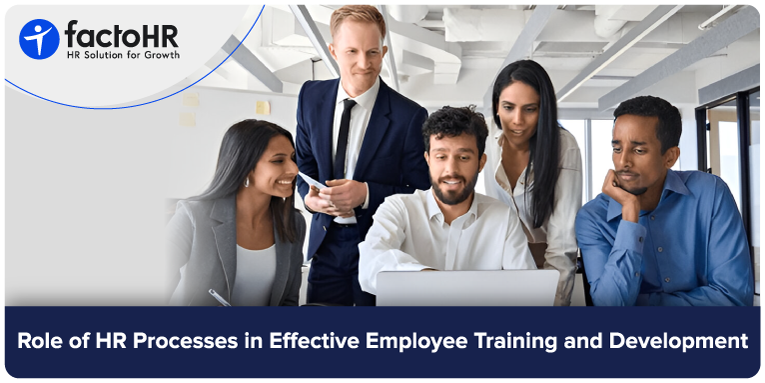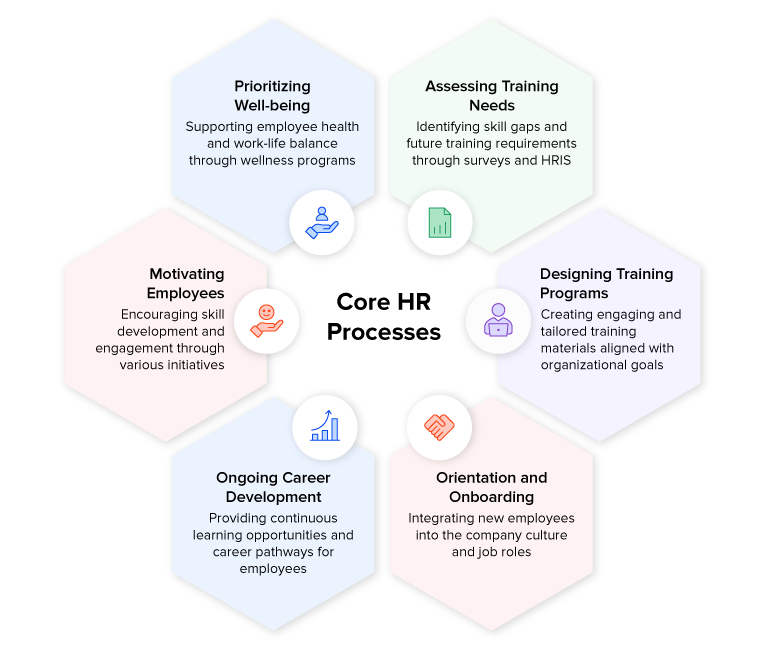The Role of HR Processes in Effective Employee Training and Development

Table of Contents
The training and development function is one of the most important parts of HR processes. When organizations focus on investing in training and development programs, they can enhance their human resources (HR) processes. Companies encounter various challenges with training programs, such as engaging employees and allocating resources effectively. Additionally, they must invest their time and effort to remain relevant in their roles within the organization.
Training and development is a structured process that an organization uses to improve its employees’ skills and knowledge. These processes also enhance an employee’s performance by combining their capabilities with the organization’s goals. This includes needs assessments and designing programs for more effective learning. This article explores some of the key HR processes involved in employee training and development, emphasizing the importance of continuous learning.
Core HR Processes in Employee Training and Development

Effective employee training and development programs help improve employee performance and productivity. The core HR processes in employee training and development aim to use an individual employee’s strengths to the fullest. Some of these core HR processes are mentioned below:
Assessing Training Needs
Organizations can identify gaps between the skills of current employees and the knowledge required for future performance. They can also identify areas where training is required when they find performance issues and frequent technological changes that require employees to learn new skills. This way, the performance evaluation process can be conducted, and specific training needs can be identified. All of these will lead to more targeted training and effective learning programs.
Some of the ways to assess training needs are surveys and questionnaires. Companies can understand their workforce’s ideology for areas of improvement through quantitative and qualitative data. An HRIS can help companies identify skill gaps with the help of HR data. The software provides reports and analytics on the qualifications of current employees, enabling informed decision-making.
Designing and Developing Training Programs
The organization’s goal is to ensure that employees’ skills and knowledge align with the organization’s performance goals. The assessment process is complete when the skills needed for various job roles are identified. The next step is to develop training programs.
HR collaborates with department managers to develop engaging training materials tailored to assessment needs. Training content is selected, and some of the most effective methods include presentation and online modules. The training and development program should include on-the-job training and workshops to increase employee engagement.
Orientation and Onboarding
Orientation includes introducing new employees to the company and its culture. Some core functions include explaining company policies and procedures to help new employees get an overview of the firm. They are also introduced to their team members and their workspace. This process helps avoid confusion regarding processes and builds a positive impression.
The onboarding process includes integrating new employees into the company and their specific job roles. Employees are given job-specific training and mentorship programs to help them be more productive in their work. This way, organizations can provide a smooth transition for new employees and jobs for better engagement. A well-structured orientation and onboarding program helps reduce employee turnover as they feel supported in their work.
Ongoing Career Development
HR professionals play an important role in identifying employees’ training and development needs. By knowing employees’ strengths and weaknesses, training programs can be designed accordingly. Organizations and HR professionals can also promote a culture of learning by providing opportunities for their employees.
The training and development programs are continuously assessed to measure their effectiveness. Adjustments are made to meet the needs of the organization as well as employees. Ongoing career development also includes gathering feedback from employees and tracking performance metrics to measure the impact of the program. Providing employees with growth opportunities helps them take ownership of their career development and increases retention. Creating career pathways and offering opportunities also helps in succession planning.
Motivating and Engaging Employees
Creating a culture of continuous learning, employees are encouraged to develop their skills. Training programs help them stay updated with industry trends and practices, which boosts overall performance. Employees’ skills are enhanced through career development programs and on-the-job training.
Employee engagement can also increase as they feel more connected to the organization. Survey forms and regular team meetings are two ways employees can feel a sense of purpose within the organization. Effective training and development programs can enhance employee performance, ultimately leading to increased job satisfaction. These programs help employees understand that the organization values their health by providing wellness programs.
Prioritizing Employee Well-Being
Employee training and development programs create a supportive and engaging environment for employees to grow and learn new skills. This makes them feel supported both personally and professionally. Organizations can offer wellness programs and stress management workshops to help employees support their physical and mental well-being.
Organizations can offer flexible work arrangements and clear, measurable goals to help promote a healthy work-life balance. When employees feel supported, they are more likely to stay engaged in training and development activities. They are also motivated to learn new skills and apply them. Focusing on these activities creates a more engaged workforce and reduces stress.

Common Challenges in HR-Led Training and Development
There are some common challenges in HR-led training and development programs. These are
- When organizations implement training and development programs, it can be difficult to align the needs of both the organization and its employees.
- The programs need resources to be allocated efficiently, and sometimes this can be costly.
- There are multiple types of training programs, and selecting the best one can be challenging.
- Employees also have to attend to their routine work, which makes it difficult for organizations to maintain employee engagement.
- Quantifying the effectiveness of a training program can be challenging, making it difficult to make informed decisions.
- Companies may face resistance from employees for a change when training programs are introduced.
Conclusion
HR processes play a crucial role in determining the success of employee training and development programs. Organizations that establish a structured training program by identifying skills gaps can help employees learn new skills, increasing productivity and driving organizational performance.
Organizations that foster a culture of continuous learning increase employee engagement and performance. To promote training and development programs, factoHR offers a core HR platform designed to simplify core HR processes. Organizations can easily measure the effectiveness of employee development programs and improve their HR processes.
What are the Steps in the HRM Training and Development Process?
The steps in the HRM training and development process include:
- Needs assessment and methods
- Design and development of the training program
- Implementation of the program
- Evaluate the program
- Provide ongoing support
Grow your business with factoHR today
Focus on the significant decision-making tasks, transfer all your common repetitive HR tasks to factoHR and see the things falling into their place.

© 2025 Copyright factoHR


